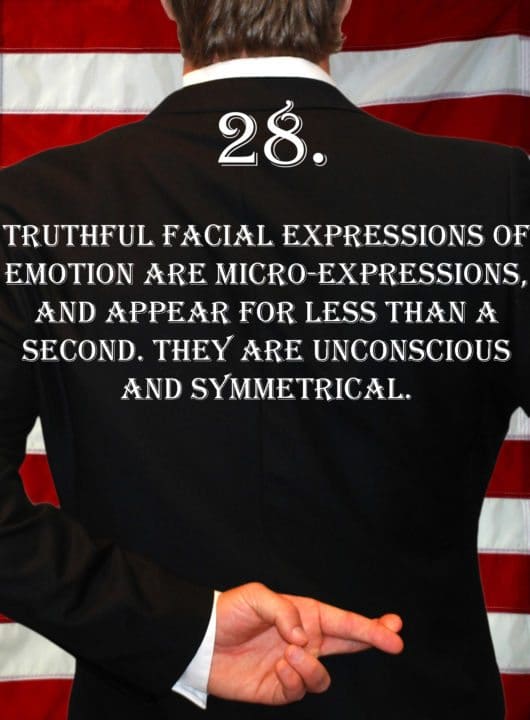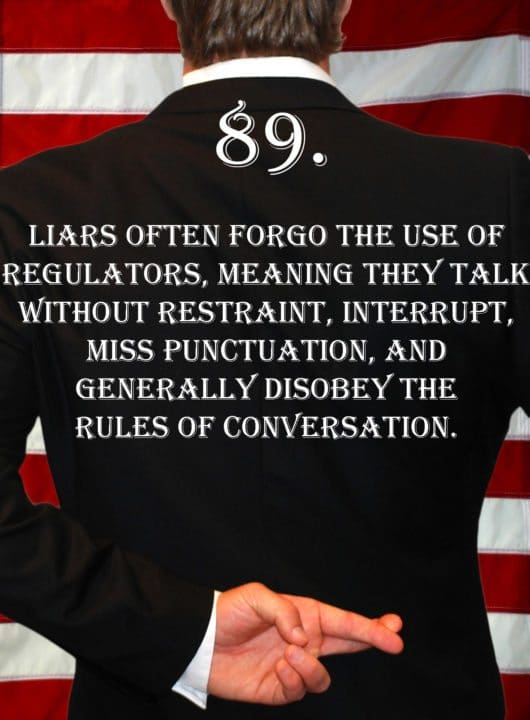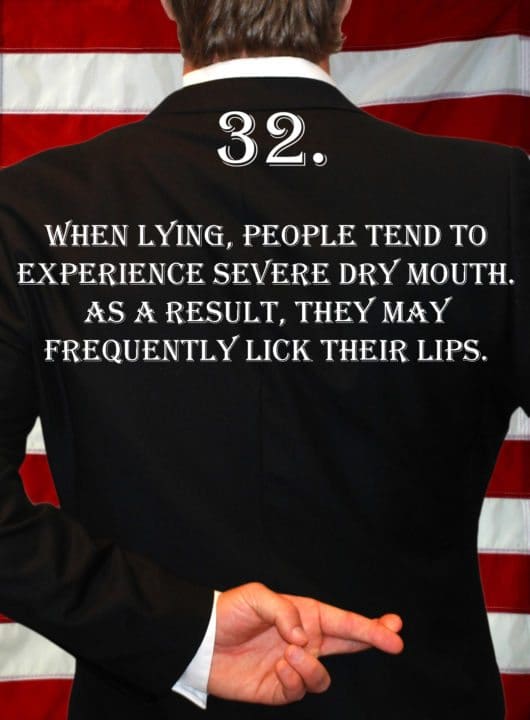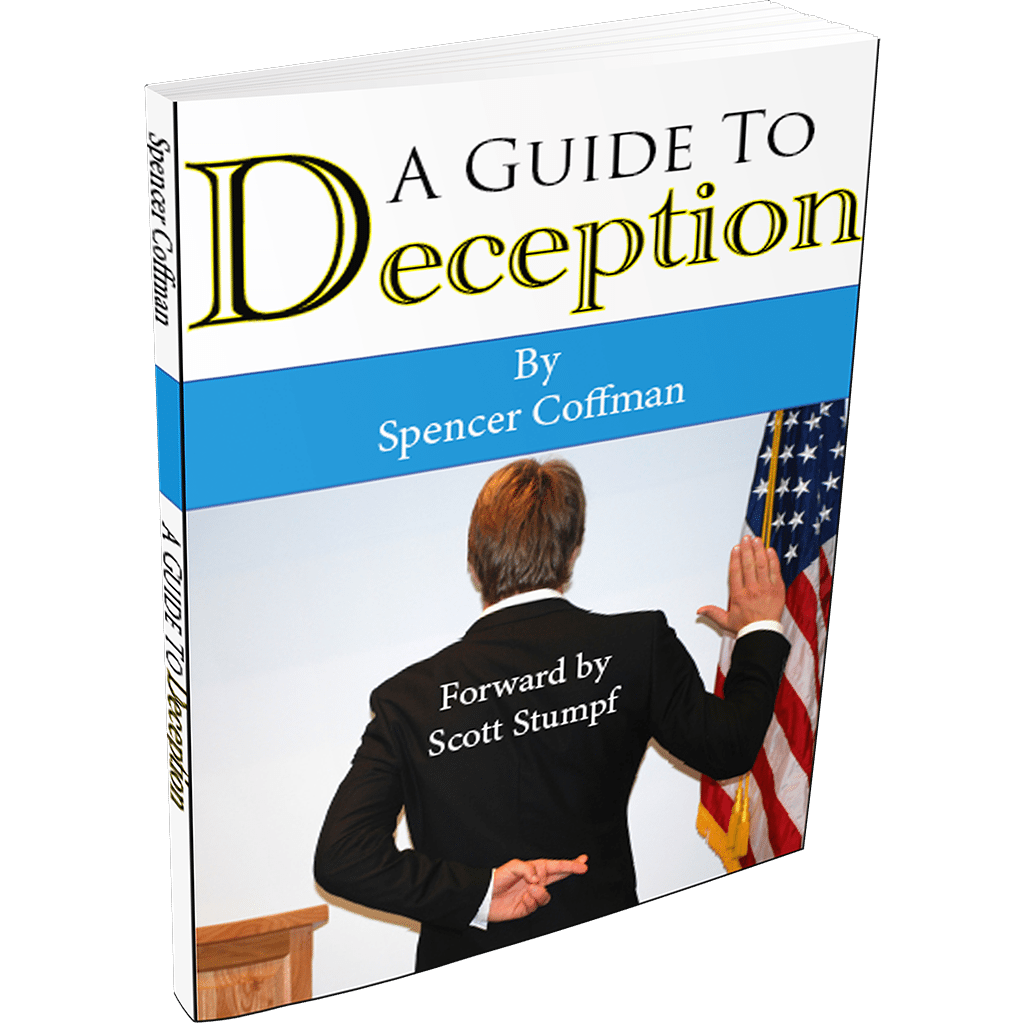
Deception Tip 28:
Truthful facial expressions of emotion are micro-expressions, and appear for less than a second. They are unconscious and symmetrical.
Listen To The Podcast!
E28 – Micro Expressions – Deception Tips Podcast – Click Here To Subscribe
Podcast Transcript
Hello and welcome to the deception tips podcast where you will learn amazing cues to detect deceit that will help you read people like never before. I’m your host Spencer Coffman, let’s get started.
Welcome to episode 28 of the deception tips podcast. We’ve been on an amazing journey. We’ve been detecting deception, learning signs of deceit so that you will never be taken advantage of or never be lied to again.
Now, of course, you are going to be lied to, however, this time you will be able to detect the truth. You will know whether or not someone is lying to you.
We’ve gone over 27 different signs of deception. 27 little tips that you can use to help you determine whether or not someone is telling the truth. These tips will help you in all walks of life.
They help you whether you are at home, with your kids, your family, your spouse, at work, etc. Even making purchases, buying a car, buying something from someone at the grocery store, Craigslist, Facebook Marketplace, whatever the case, deception is all around you and you can either choose to ignore it and potentially be taken advantage of or acknowledge it and make sure that you know whether or not someone is telling the truth.
Last time, we spoke of a different technique you could use that is mainly on when someone is lying to get out of something. This is a standard interrogation technique. It is something that you’re not really going to use when you are making a purchase, you’re buying something on Marketplace or wherever.
This is something that is going to happen when you are questioning your child about where they were or what they were doing or if they did this or some kind of a punishment type of thing.
We talked about suggesting consequences, and basically, what that is, is when someone lies, and they are about to be caught in their lie, you can start bringing in a different technique of suggesting a consequence.
Basically, all it is is asking them for their opinion. You say, “Hey, so what do you think would be an appropriate consequence for someone who potentially does XYZ?”
Now, you’re not accusing them of doing it, you’re questioning them and then you’re going to get their opinion on how they would handle the situation. Now, it’s very important because this is before you are certain they did it. They haven’t confessed yet, this is pre-confession.
So, let’s say your child has broken something and you say, “well, what about this?” And they say, “no, it wasn’t me, I didn’t do it, the dog did it.” And you say, “well, how about we talk about this, and what would be a typical consequence for someone who didn’t listen to their parents and because they didn’t listen, something broke?”
And the kid says, “well, maybe XYZ” and they come up with some really light thing like, “well, maybe they have to do an extra chore or something.” And the common-sense consequence would be well because they didn’t listen, they deliberately disobeyed and maybe they would lose their TV privilege for a couple of days, something like that, a little bit more sensical.
Someone who is lying is going to give less of a consequence because they know that that consequence could be coming to them. So, they’re going to suggest something a little more easygoing, a little bit more lenient.
However, if people are honest and truth-telling about their innocence, they are going to give a more common-sense consequence, something that fits the situation because unconsciously they know that they’re not going to get that consequence.
They know that they’re telling the truth, so they know that they’re going to give a consequence and it’s not going to come back on them. They’re certain of that because they’re telling the truth. So, this is a cool technique that you can use to help you determine whether or not someone is really lying.
Now, of course, this isn’t going to be foolproof and it’s not going to happen every time. This is why you need to look for patterns and clusters of behavior and use this as one tool in your arsenal because sometimes a person who is lying may give truthful or a common-sense consequence knowing that well if I do this then they’re going to think I’m telling the truth.
People are always going to be out there trying to manipulate a situation, one way or another, so watch out for multiple patterns of behavior and multiple signs of behavior.
Today, we are going to talk about perhaps one of the most difficult signs to read but it is also the most reliable. In addition, it is one of my favorite signs because you always know for certain what they mean, and you know what is happening around it and where they’re coming from, it’s just that reliable, it’s excellent. However, they are the most difficult to see because they are only on the face for a very short time. It is a split second. It is something like a quarter of a second, these are micro-expressions.
Now, these micro expressions happen through the muscles of the face and they go way back to a guy named Paul Ekman who did research on all ofthe muscles on the face and he developed something called the facial action coding system.
He cataloged and coded all of these little muscle movements and the meanings behind them, so that if your eye twitches one way or they raise, or your mouth goes something sideways it means this, this, or this. And then all of that, of course, plays into body language as well but the facial expressions, the micro-expressions are very reliable.
Usually, they happen first, and body language follows. So, if you don’t see the micro-expressions, don’t worry because there will be other signs after that. However, if you can start training yourself to see micro-expressions, then you can watch for the body language after to confirm what you saw. This is an excellent way to practice reading micro expressions because they are so quick. They are very short, so they are very difficult to see.
However, there are a lot of training tools out there, you’ll have to pay for them, of course, that can help you with micro-expressions. They can help you watch people, detect deception, and other emotions, that’s why these micro-expressions are so cool because it isn’t only for deception.
You can have micro-expressions for any emotion and the Ekman group, Paul Ekman Group, has created tons of tools available to train you on reading micro-expressions should you be interested in them.
However, today we are going to talk a little bit about it. So, here it is, deception tip number 28, truthful facial expressions of emotion are micro-expressions and appear for less than a second, they are unconscious and symmetrical.
Here it is again, truthful facial expressions of emotion are micro-expressions and appear for less than a second, they are unconscious and symmetrical.
Now, it’s important to note here that when I say they are truthful facial expressions, that’s micro-expressions. There can be truthful facial expressions of emotion that are not micro-expressions, of course.
However, any time you see a microexpression it is 100% truthful. There are no fake micro-expressions unless someone has trained their face to become that way and they model these micro expressions when they want them, of course, they’re fake. But for the majority of people, 99% of them, micro expressions are going to be 100% true.
Even on the people who can fake them, they’re going to be fake in that instance but otherwise whenever they’re shown, you can see that, and they are true. Whereas, a smile, could be fake, so a smile is not always 100% true.
Whereas a micro-expression is one that 99% of the people, is always 100% true. On the other one percent, those are people who have trained their bodies to be able to mimic those micro-expressions.
Those are really the only people who are probably involved in some kind of a scientific study to be a model so that people could read them and watch for micro expressions.
Or like when you look at the videos to help you train yourself, that person is probably a model because they needed to make sure certain muscles are moving to mimic a real micro expression. So, in that person, they were doing that on purpose, but it is still a truthful facial.
They are unconscious in the fact that we don’t think about micro Expressions. They happen so fast, they aren’t even in our conscious thought, it’s something that happens instantly and then they are symmetrical. Now, this doesn’t mean that they are going to happen on both sides of the face at all times because they will not.
Sometimes micro-expressions, like contempt for instance, which is asymmetrical, we talked about that a long time ago. That is the only asymmetrical facial expression, that was way back in episode 19. Now, other expressions on the face are going to be symmetrical and we’ll talk a lot more about it coming up right after this.
Would you like to know if you are being lied to? Lies are everywhere and they could be happening to you. A guide to deception is a great book filled with information on how to spot lies. Get your copy today online at Spencercoffman.com.
Most gestures, most body language postures, etc. should happen on both sides of the body, everything should be symmetrical. The thing with micro-expressions though, is that since they can be so quick, and they can happen so fast, they may not always be there. A little twitch of a corner of an eye is not going to happen on both eyes. Now, genuine basic emotions of micro expressions, are pretty much going to be symmetrical.
Disgust may not be symmetrical even though that is considered a basic emotion, but things like happiness and enjoyment, things like surprise and fear are going to show up in both eyes. Happiness and enjoyment are going to be on both sides of the mouth.
But a lot of micro-expressions can be seen especially in detecting deception that is on the face that are simple little things such as a pulse of a vein in the neck, something like a little twitch on the facial muscle, corners of the mouth, corners of the eyes, things like that, those are not always going to appear on both sides of the face.
However, they will be symmetrical in their movements. It’s not going to be a non-fluid movement. It will be something that happens from beginning to end and is very, very quick. It is genuine human emotion. It is something that is unconscious and is produced for a split second based on a fleeting thought or some kind of fleeting emotion.
A lot of times humans, we think and chemically and physically react in our bodies so quickly to what we want to do and then our mind, our conscious mind, holds it back and says well, that wasn’t the right way to do it.
We need to have a more diplomatic approach, or we need to be a little bit more sensitive or something like that, we need to approach it or tread carefully. So, then we, our conscious, tones it down and brings forth the socially appropriate responses or actions to those feelings that we have.
Therefore, the micro-expression comes on and the way we really feel, and then our conscious covers it all up, and then some of our other expressions and our mannerisms portray forward with how we are supposed to handle the situation or how we’re supposed to feel. So, that is one thing to watch with micro-expressions, they’re going to happen before anything.
Usually, micro-expressions do not keep occurring the entire time through everything, at least not the ones that you are going to want to watch for. Of course, your facial movements are going to continue to happen throughout the entire conversation.
Micro-expressions, however, are going to be predominant when you are questioning or asking a question or when someone is telling their story. That is when you are going to want to watch for them because there, they will be the most reliable because you will be directly asking them some form of a question.
That first thing that pops into their head is going to promote a micro-expression or some kind of a facial tic on their face. That is what you’re going to want to watch for because that is the unconscious truth coming out instantly. Then the body language will follow, if their story comes out then the unconscious is going to start leaking other body language that you can pick up on as well.
The main thing about micro-expressions is to remember that they are always going to be 100% truthful. So, if you can start to see them, you’ll know the truth anywhere you see it. It will be something that you can rely upon fully.
Now, they are very difficult to spot because they are so quick, and they are not happening like a body language gesture where you’ll see it happen. It is something that is under the scenes, it is something that is so fast and so small that it is a lot more difficult to spot.
However, it is definitely worth the time and effort to learn how to see them and to practice seeing them everywhere you go because they can help you with a lot more than simply detecting deception.
You can see all kinds of emotions happiness, sadness, fear, surprise, and love, all of those emotions are visible if you can see micro-expressions. It helps you out a lot more in life, so you can better relate to other people and really care about them, etc. because you’ll be able to see a lot more than just deception.
And of course, with body language, you can see a lot more than deception as well, but this is focused on deception because, after all, the deception tips podcast. So, work on learning some micro-expressions if you have that desire, and keep listening to these podcasts because they will help you detect deception.
I want to thank you for listening to the deception tips podcast, and for regularly tuning in every week. I hope that you’ll share it with your friends, subscribe to the feed, check out the deception tips videos, and the deception tips blog, and take a look at the books I have available. And as always, tune in next week for a new deception tip.
Video Transcript
Hey guys, my name is Spencer Coffman, thank you for watching the deception tips videos. They’re all about teaching you how to read people and detect deception so that you will be able to tell if someone is lying to you.
Today, we’re going to talk about a cool thing, this is a facial feature that you can see with training. Very few people can naturally see them, they’re very difficult to see but through all of this, through these videos, through practice and watching yourself in the mirror, becoming more aware of your own body and how you are expressing things, you will be able to see them with a lot more training.
They are micro expressions, they happen in less than a second, they are very, very quick, some of them even a quarter of a second. They’re very, very difficult for you to see it’s more like a twitch or a muscle spasm or something that is very slight. So here it is, this is deception tip number 28, truthful facial expressions of emotion are micro expressions and appear for less than a second, they are unconscious and symmetrical.
So, they are unconscious which means they happen right away, they’re super quick, they’re instant, people are not consciously thinking about them. Sort of like a smile that’s fake, you consciously put that on your face, it’s not natural it’s something that is thought about and then done. Whereas these are micro expressions, they are unconscious, they are natural, and they happen in an instant.
They’re very, very quick and they happen so fast that unless you are really paying attention to them or unless you’re really watching the face, you can’t see them. Sometimes it’s even more difficult like if you’re having a conversation with someone, you are focused on the conversation and watching their face, you may miss them even there. So, usually when you’re trying to watch for micro expressions it would be best to have someone else ask the questions or someone else watch the person. Then, you would be able to focus only on their face and on their body and on what they’re doing to watch for those micro expressions because they are very difficult to see.
Even with training, they are tough to see because they happen so very quick and there are so many different muscles in the face and so many different tendons and ligaments and things that go together. When something happens, it could happen in multiple different places and it could also have multiple different meanings. Depending on what other behaviors go with that one, what other clusters or what other patterns, body language signs, the speech that goes with it, they could all have different meanings or different potential meanings with that.
So, this is something that if you’re interested in micro expressions, you want to dive deeper into it, you need to get some micro expression training and practice on yourself. Also, watch some videos, look up pictures of micro-expressions so you can see them and get to know what they look like because the benefit is, they are 100% universal. That means they are the same on all humans, all races, ethnicity, no matter what language they’re speaking etc. they will be universal.
So, surprise on someone who is black, white, Chinese, Japanese, anything will all be the same as each other there will be no difference. Same with emotional expressions of fear, anger, disgust, all of these things will be the same. Now, what’s important is each of these expressions can play a big role in lying and deceptive behavior. So, micro expressions are something that is worth taking the time to get to learn and know and see because they will help you out in a lot more than just detecting deception.
You can also see it in all different types of emotions because micro expressions are universal just like all this other body language that you’re learning it’s all Universal. It happens across everybody but there are many different meanings and that is why you look for patterns and clusters of behavior.
So, if this is your first time watching these videos, I would love to have you subscribe to the channel on YouTube. In addition, feel free to leave any comments or questions that you have as well. Also, if you’d like some more information, we’ve got books, blog posts, podcasts, all available on spencercoffman.com that are dedicated to teaching you exactly what everybody is saying.
Until next time.






